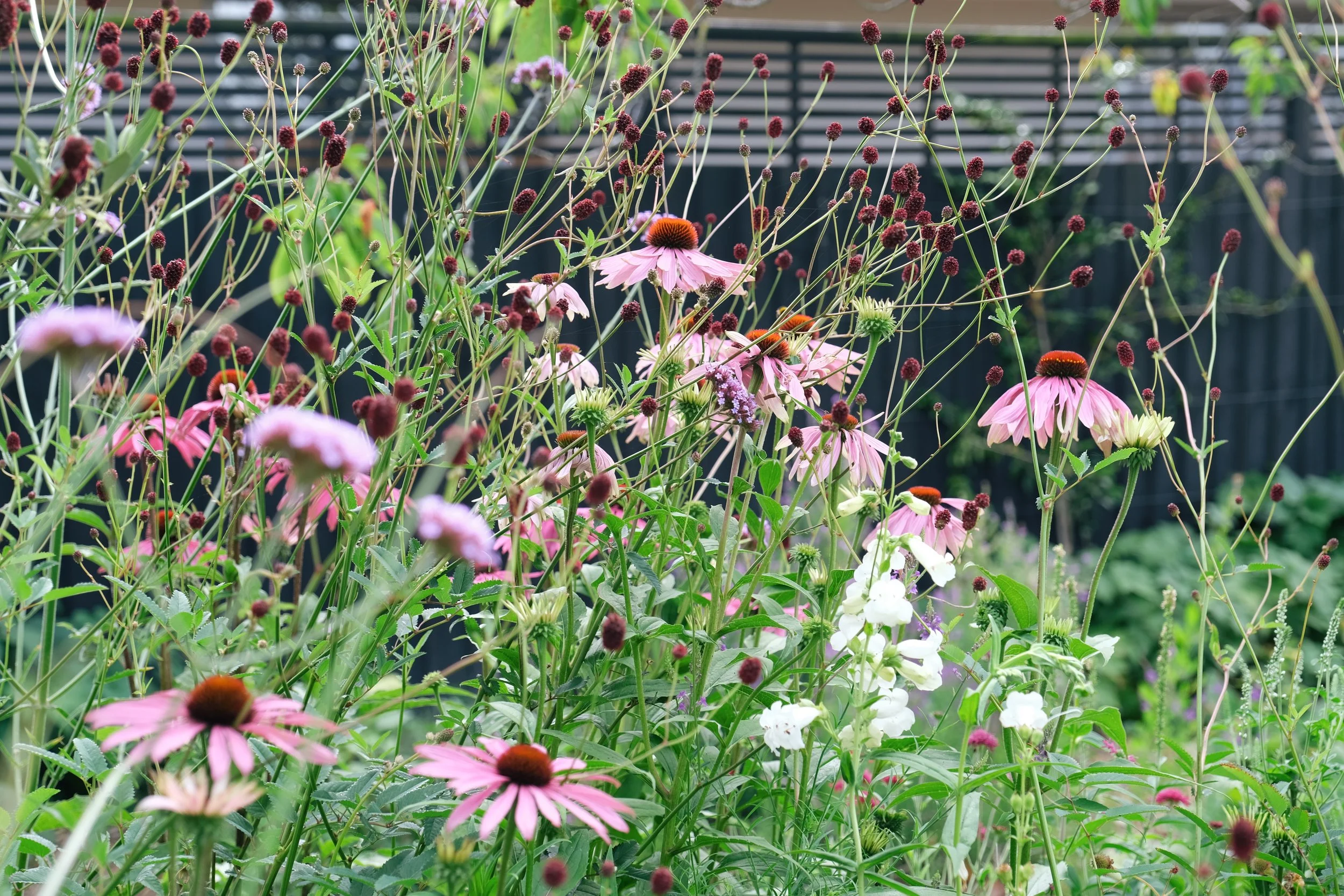Introducing Sanguisorba
/Sanguisorba officinalis with echinacea and penstemon
I am in constant review of my planting. Assuming daily positions in my garden where I gaze at my beds, mentally comparing my vision to the outcome that has arrived as the season rolls on. I lose quite a lot of time to this activity, something I think many of you might relate to, but it’s a weird practice of zoning in that seems to have served me well to date and aids in the tweaks I hope to make.
My beds are currently in a state of late summer, toppling madness. Their early summer vigour is fading and where they stood strong in the wind and weather before, my crop of Verbena bonariensis is now a collection of haphazardly leaning masts hassling their neighbours. I’m still waiting for my Salvia nemorosa to spring back from its mid-season prune while the end garden waits patiently for the sparkle of asters to reignite its interest.
Amid the tangle of airy planting are the slim rigid arms and small rusty bullets of perennial Sanguisorba officinalis. Rather than parading as the main event, this plant is the cool support act, giving kudos to its neighbours like floating full stops!
This is also one of many plants that I have had to hunt high and low for, intensely inspired by the Northern Hemisphere planting I pour over in the pages of Gardens Illustrated. Thanks to the brilliant work of our independent nurseries in New Zealand, Sanguisorba varieties are becoming easier to obtain.
The comical heads of Sanguisorba obtusa (I think…)
My foray began with the digging up and gifting of a sanguisorba that both my benefactor and I hoped was Sanguisorba officinalis. Chipped off a clump in springtime where only its small leafy mound was visible, it turned out that the guesswork was slightly off, but the unexpected result was exciting. I was amazed when it flowered, producing dense, long catkins that were impossibly pink and fluffy! Distinctly reminding me of a character from Fraggle Rock!
In my own research, I have struggled to firmly identify this variety but in comparison to those I have found, I believe it to be Sanguisorba obtusa. A lucky addition as it turns out as I’m unable to find it for sale anywhere at the moment.
Sanguisorba officinalis with eryngium
Spurred on by the magic this plant injected into my garden, I turned back to my search for Sanguisorba officinalis, gleefully finding and ordering three plants online from Puriri Lane nursery.
They took their time to establish, not flowering in their first season before rewarding me with their beautiful ferny foliage and deep crimson bobbly blooms. Since then, I have divided in the autumn and increased my garden stock to seven plants.
Sanguisorba is commonly known as burnet, with my favourite Sanguisorba officinalis referred to as Great Burnet. Native to temperate regions of the Northern Hemisphere, they are rewarding in their hardiness as much as their display. Most ornamental varieties are defined by their winter dormancy (they completely disappear) and mid-spring clump forming of lovely divided leaves, often with softly serrated edges.
Flowers are borne on top of wirey slim stems that can reach up to 2 metres in height depending on the variety. Sanguisorba flowers are often quite recognisable in their unusual spherical structure ranging across types from tightly packed bobbles to longer, fluffy bottlebrush forms.
While they thrive in full sun and free-draining soil, they also cope in partial shade, enjoying top-ups of water particularly as they establish. Their incredible delicate and airy habit makes them great partners for naturalistic, prairie-style mixed plantings but they would also look architectural and modern planted en masse together. Despite many being quite tall, their open structure allows them to be planted closer to the front of a border than others of the same mature height.
Sanguisorba officinalis winding its way up through mixed perennials including echinacea and veronica.
My own are interplanted with Verbena bonariensis and echinacea, a favourite combination. While there are earlier varieties, Sanguisorba officinalis flowers from early summer, with its interest carried right through into the winter months if flowers are left to form seedheads on the plant. These very closely resemble its bloom which gives a feeling of endless flowering.
You can, of course, prune back the flowers and foliage before seedheads are established but I tend to leave and cut back the dead stems to ground level in August.
Being great picking as well as offering an eye-catching form in any garden bed, Sanguisorba only tops off its good looks with its very easy-going needs once established. Seek some out!
This is an expanded version of the article featured in my Stuff ‘Homed’ gardening column for beginners , The Press, Dominion Post and other regional papers on March 2nd 2023
All words and images are my own, taken in my home and garden in Christchurch, New Zealand unless otherwise captioned.






